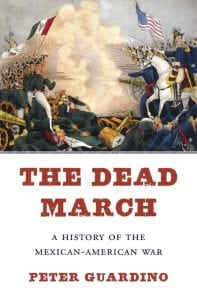Book review by Kyle B. Carpenter
In her debut monograph, Manufacturing Advantage: War, the State, and the Origins of American Industry, Lindsay Schakenbach Regele produced an outstanding history of Early American capitalism. She argues that the American arms and textile industries became the focus of policymakers’ efforts to create national security after the American Revolution in order to protect the United States from reconquest and move on from dependence on British manufactured goods. An excellent political economy of Early America, the book shows the clear connections between the American state and business interests from the moment the United States declared its independence. It also hits on the major themes of national security, nationalism, and U.S. territorial and economic expansion. I found the book to be a joy to read as it contributes a valuable new concept, is tightly organized and always stays on point in its argumentation.
Schakenbach Regele offers historians of American political economy a new concept: national security capitalism. She defines it as “a mixed enterprise system in which government agents and private producers brokered solutions to the problems of international economic disparities and war.”[1] A forerunner to Eisenhower’s notion of the military industrial complex, national security capitalism neatly summarizes that the United States never completely adhered to free-market capitalism. Federal subsidies, government contracts, and protectionist tariffs for the arms and textile industries ensured the United States could withstand international conflict. The concept usefully provides a shorthand for future historians to utilize without having to delve into the depths of the connections between state and business in Early America on their own. Schakenbach Regele did all the work and wrapped it in a neat three-word concept.
 In terms of its construction, Manufacturing Advantage is chronologically organized and adheres to its tightly woven argument. She begins the book with the supply nightmares George Washington faced during the Revolution and uses Valley Forge to ground her argument in the reality of shortages of clothing and arms. The framers of the constitution, keenly aware of the war’s supply problems, included executive powers for presidential cabinets and staffing to bolster manufacturing without having to wait for congressional legislation. Schakenbach Regele then takes the reader through all the formative decisions made by succeeding presidents and their cabinets from Washington to Polk, hitting all the major events from the embargo under Jefferson, the War of 1812, expansions into Latin America, and finally the U.S.-Mexico War. In each chapter, the author sticks tightly to her argument by explicitly showing how policymakers supported the arms and textile industries.
In terms of its construction, Manufacturing Advantage is chronologically organized and adheres to its tightly woven argument. She begins the book with the supply nightmares George Washington faced during the Revolution and uses Valley Forge to ground her argument in the reality of shortages of clothing and arms. The framers of the constitution, keenly aware of the war’s supply problems, included executive powers for presidential cabinets and staffing to bolster manufacturing without having to wait for congressional legislation. Schakenbach Regele then takes the reader through all the formative decisions made by succeeding presidents and their cabinets from Washington to Polk, hitting all the major events from the embargo under Jefferson, the War of 1812, expansions into Latin America, and finally the U.S.-Mexico War. In each chapter, the author sticks tightly to her argument by explicitly showing how policymakers supported the arms and textile industries.
In fact, my one critique of the book is that it may at times be too tightly organized. Some sections of the book could benefit from the narrative loosening up to explore the broader context. For example, in chapter 6, “Industrial Manifest Destiny,” the author gives a brief background of the United States’ expansion into Oregon and Mexico but spends most of the chapter’s focus on changes to the Ordnance Department. I think this section of the book had an opportunity to expand a bit to explain the continued British and French presence in Texas and how it enflamed U.S. nationalism. Since nationalism was a key element in the unity between the state and manufacturing industry, further exploring the context of rising nationalism might help make the argument even more forceful.
My critique is merely how to make an excellent book even better. Manufacturing Advantage remains an incredible contribution to the history of Early American capitalism and political economy. Its conceptual framework and organization make it an accessible read for any scholar interested in the topic.
[1] Lindsay Schakenbach Regele, Manufacturing Advantage: War, the State, and the Origins of American Industry, 1776-1848 (Baltimore: Johns Hopkins University Press, 2019), 2.


 Throughout the book, Guardino builds a sustained and compelling case against a myth that has long haunted interpretations of the Mexican-American War in both countries. This myth suggests that Mexico lost the war primarily because it lacked the stability and national unity of its northern neighbor. Guardino, on the other hand, shows that the war’s outcome had far more to do with the economic and social disparities between the two countries. An assortment of geographical, political, and social forces combined to give the U.S. a strong material advantage. At the same time, costly mobilization efforts, a violent U.S. occupation, and the U.S. Navy’s blockade of Mexican ports compounded Mexico’s already dire economic situation and aggravated its internal conflicts. The loss of revenue from import duties crippled the financially strapped Mexican state, while the war’s demands further burdened a society already living on an economic knife-edge. Given this harsh reality, Guardino shows that the fierce and sustained resistance that Mexicans made against the U.S. invasion was nothing short of remarkable. Working to overcome deep internal divisions and constantly weighing the stark realities of personal and family survival, Mexicans from all walks of life contributed to and participated in the war effort. In doing so, they unequivocally declared and demonstrated their Mexican nationalism. “In short,” Guardino concludes, “Mexico lost the war because it was poor, not because it was not a nation” (367).
Throughout the book, Guardino builds a sustained and compelling case against a myth that has long haunted interpretations of the Mexican-American War in both countries. This myth suggests that Mexico lost the war primarily because it lacked the stability and national unity of its northern neighbor. Guardino, on the other hand, shows that the war’s outcome had far more to do with the economic and social disparities between the two countries. An assortment of geographical, political, and social forces combined to give the U.S. a strong material advantage. At the same time, costly mobilization efforts, a violent U.S. occupation, and the U.S. Navy’s blockade of Mexican ports compounded Mexico’s already dire economic situation and aggravated its internal conflicts. The loss of revenue from import duties crippled the financially strapped Mexican state, while the war’s demands further burdened a society already living on an economic knife-edge. Given this harsh reality, Guardino shows that the fierce and sustained resistance that Mexicans made against the U.S. invasion was nothing short of remarkable. Working to overcome deep internal divisions and constantly weighing the stark realities of personal and family survival, Mexicans from all walks of life contributed to and participated in the war effort. In doing so, they unequivocally declared and demonstrated their Mexican nationalism. “In short,” Guardino concludes, “Mexico lost the war because it was poor, not because it was not a nation” (367).
